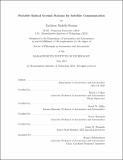Portable optical ground stations for satellite communication
Author(s)
Riesing, Kathleen Michelle
DownloadFull printable version (8.210Mb)
Other Contributors
Massachusetts Institute of Technology. Department of Aeronautics and Astronautics.
Advisor
Kerri L. Cahoy.
Terms of use
Metadata
Show full item recordAbstract
Small satellite technical capabilities continue to grow and launch opportunities are rapidly expanding. Several commercial constellations of small satellites for Earth observation and communications are making their way onto orbit, increasing the need for high bandwidth data downlink. Laser communications (lasercom) has the potential to achieve high data rates with a reduction in power and size compared to radio frequency (RF) communications, while simultaneously avoiding the significant regulatory burden of RF spectrum allocation. Lasercom benefits from high carrier frequencies and narrow beamwidths, but the resulting challenge is to precisely point these beams between transmit and receive terminals. Arcsecond to sub-arcsecond pointing is required from both the space terminal and the ground station. While existing lasercom ground stations have primarily utilized professional telescopes at observatory-class facilities, making optical ground stations more affordable and transportable is a key enabler for expanding lasercom to small satellites and new applications, as well as establishing networks to mitigate the effects of weather. We describe the development of the Massachusetts Institute of Technology Portable Telescope for Lasercom (MIT-PorTeL) utilizing an amateur telescope augmented with an externally mounted receiver assembly. The ground station has a 28 cm aperture and utilizes a star tracker for automated calibration. The ground station reduces mass by at least 10x and cost by at least 100 x over existing optical ground stations. We present a ground station architecture that enables deployment in less than one hour and that is capable of tracking satellites in low-Earth orbit. We describe the receiver assembly and fine pointing system that enables arcseconds-level pointing accuracy. Finally, we present results from testing the ground station on the roof of an MIT building tracking a star and tracking the International Space Station.
Description
Thesis: Ph. D., Massachusetts Institute of Technology, Department of Aeronautics and Astronautics, 2018. This electronic version was submitted by the student author. The certified thesis is available in the Institute Archives and Special Collections. Cataloged from student-submitted PDF version of thesis. Includes bibliographical references (pages 113-125).
Date issued
2018Department
Massachusetts Institute of Technology. Department of Aeronautics and AstronauticsPublisher
Massachusetts Institute of Technology
Keywords
Aeronautics and Astronautics.